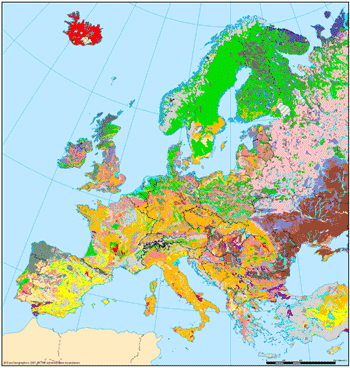Brussels, Belgium
April 28, 2005
 Soil
performs a multitude of environmental, economic, social and
cultural functions and thus plays a vital role in conserving
biodiversity and supporting global environmental systems. It is
a living system and once destroyed it is lost forever. Erosion,
contamination, decline of organic matter content, sealing due to
factors such as housing and infrastructure, landslides and
flooding all contribute to the degradation of a resource that is
fundamental to our survival. The European Commission has
therefore created the first
Soil Atlas of
Europe, designed to describe and explain the threats to our
soil, and raise awareness of its diversity and its importance to
our lives. The Atlas will contribute to future actions to
protect Europe’s soil, such as a proposal for a Thematic
Strategy on soil protection, scheduled to be put forward by the
Commission before the end of 2005. Soil
performs a multitude of environmental, economic, social and
cultural functions and thus plays a vital role in conserving
biodiversity and supporting global environmental systems. It is
a living system and once destroyed it is lost forever. Erosion,
contamination, decline of organic matter content, sealing due to
factors such as housing and infrastructure, landslides and
flooding all contribute to the degradation of a resource that is
fundamental to our survival. The European Commission has
therefore created the first
Soil Atlas of
Europe, designed to describe and explain the threats to our
soil, and raise awareness of its diversity and its importance to
our lives. The Atlas will contribute to future actions to
protect Europe’s soil, such as a proposal for a Thematic
Strategy on soil protection, scheduled to be put forward by the
Commission before the end of 2005.
Janez Potočnik and Stavros Dimas, European
Commissioners for Science and Research and Environment launched
the Soil Atlas
at the European Parliament during the Info Days on the
activities of the Commission’s DG Joint Research Centre.
Commissioner Potočnik said: “We definitely undervalue the
contribution of soil to our bio-diversity, but unless we protect
it better, we will soon realise its importance in the worst
possible way – by seeing the problems caused by its loss. Tools
such as this Soil
Atlas are an invaluable aid for policy-makers when
considering measures to protect our soil, and for the general
public, in raising awareness of its importance.” Environment
Commissioner Stavros Dimas added: “European soil is an immensely
valuable but finite resource, which requires protection to
ensure future food security and environmental quality”.
Why does soil need protection? It is a natural
living system, crucial to human activities as well as ecological
functions. It forms over very long periods of time and once
destroyed, for instance by pollution, intensive urbanisation or
inadequate agricultural and forestry practices, it is
effectively lost to present and future generations.
It is in this context that the Commission has
coordinated the creation of the first “Soil
Atlas of Europe” by bringing together expert scientists from
soil institutes in over 40 countries, all of them represented in
the European Soil Bureau Network. The Atlas consists of high
quality soil maps and easy to understand texts supported by
unique photographs. It is based on the European Soil Information
System developed by the Commission covering the whole European
Union and bordering countries.
The Atlas attempts to illustrate the complex
inter-linkages between soil degradation processes and threats to
human health and security by describing and mapping major soil
functions. The Atlas also discusses the principal threats to
soil across Europe.
Europe is favoured with highly productive
agricultural soil but the continent also has vast natural and
semi-natural lands, in which soil plays a vital role by
conserving biodiversity and supporting global environmental
systems. To date, an explicit European Soil Policy has not been
defined but a Thematic Strategy on Soil protection, which will
include a Soil Framework Directive, is scheduled by the end of
2005.
http://www.jrc.cec.eu.int/soil-atlas |